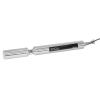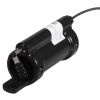Zebra-Tech TriOS NICO Hydro-Wiper
Features
- Highly effective brush technology for both marine and fresh water
- Precision on-board clock for accurate wipe interval timing
- Simple sensor installation and operation with user-replaceable brush
- Free ground shipping
- Expedited repair and warranty service
- Lifetime technical support
- More
Overview
The Zebra-Tech TriOS NICO Hydro-Wiper is a mechanical wiper system designed to fit easily to the TriOS NICO UV nitrate sensors (also compatible with OTT ecoN). Using a regular gentle brushing action, the Hydro-Wiper keeps the optical window of the sensor clean from bio-fouling and other unwanted deposits such as mud. The Hydro-Wiper reduces the need for costly site visits to manually clean the instrument, maintaining data integrity throughout long deployments.
Self-Contained
The Zebra-Tech TriOS NICO Hydro-Wiper consists of a wiper unit attached via a purpose-designed clamp. The wiper unit is connected to a rugged underwater housing that contains the batteries, control electronics, diagnostic LED and wipe interval select switch.
Data Logger Controlled
The control module is a small, rugged wiring panel connected to a power supply and a data logger. The data logger initiates wipes using a trigger signal. Synchronizing the wipe with measurements from the instrument ensures data quality that remains consistent throughout the deployment.
- (1) Zebra-Tech TriOS NICO Hydro-Wiper
- (1) Field kit
- (1) Operations manual
In The News
Save our Bogs! Culture, Conservation and Climate Action in Ireland’s Peatlands
Characterized by long-term accumulation under waterlogged conditions, peatlands exist on every continent and account for 3-4% of the global land surface . Small but mighty, these often overlooked wetland environments are estimated to hold as much as one-third of the world's organic carbon in their soil—twice the amount found in the entirety of the Earth's forest biomass. While healthy peatlands can trap and store carbon, regulate water, and provide important habitats for rare species, human alteration has disturbed peatland carbon and nitrogen cycles on a global scale. Approximately 12% of the world’s peatlands have been drained and degraded through conversion for agriculture, forestry, infrastructure development, and other uses.
Read MoreSargassum Surge: How Seaweed is Transforming our Oceans and Coastal Ecosystems
Until recently, Sargassum –a free-floating seaweed–was distributed throughout the Sargasso Sea , the north Caribbean Sea, and the Gulf of Mexico. But in the space of a decade, this seaweed has, as one scientist remarks , “Gone from a nonfactor to the source of a terrible crisis.” Driven by climate change, anomalous North Atlantic Oscillation in 2009-2010 and a glut of anthropogenic pollutants, sargassum has proliferated. Seasonally recurrent mats as deep as 7m now bloom in the “Great Atlantic Sargassum Belt” (GASB), which covers areas of the Atlantic from West Africa to the Caribbean Sea and Gulf of Mexico. Every year, millions of tons wash up along the shores of more than 30 countries . Dr.
Read MoreGreat Lakes Research Center: Designing Targeted Monitoring Solutions
According to the National Oceanic and Atmospheric Administration ( NOAA ), the Great Lakes have more miles of coastline than the contiguous Atlantic and Pacific coasts combined and contain 20 percent of the world's freshwater, making it a critical region to protect and conserve. Continuous monitoring and data-informed resource management are key components of managing waters in the region. Hayden Henderson, a research engineer with the Great Lakes Research Center (GLRC), designs and deploys monitoring platforms throughout the Great Lakes. With a background in environmental engineering, Henderson enjoyed the challenge of creating systems and making them work to obtain difficult, remote measurements.
Read More
















